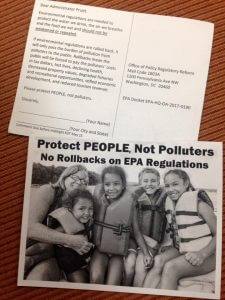Leveraging Our Voices to Protect Clean Water Policies At Risk

During River Network’s annual conference River Rally (May 2017) the Trump Administration was taking public comment on which environmental regulations it should eliminate. It was perfect timing to ask our nationwide network of community water advocates to let the Administration know that they want regulations to protect people, not polluters.
We mailed in hundreds of postcards to the EPA and worked with groups to develop detailed letters about the value of regulatory safeguards to their rivers and communities. As a result, river groups form 19 states submitted over 30 comment letters. Many organizations, including the Clean Water for All Campaign, worked together to get the word out. The EPA heard loud and clear that these safeguards are critical.
This is the work we will continue to do in 2018, to leverage the voices of our network to protect the bedrock federal policies and clean water protections now at risk. Over the past year we’ve witnessed a relentless series of attacks on our safeguards for clean water and healthy communities from the Trump Administration and Congress. There were rollbacks or delays of key environmental and health regulations, including attacks on the Clean Water Rule, the Toxic Power Plant rule, the use of science to make decisions, and elimination of new requirements to take climate impacts into consideration before we invest in big new infrastructure projects. 2017 was undoubtedly a bad year for the Environmental Protection Agency (EPA) itself.
Even with improvements from the President’s originally-proposed 2018 budget, the Senate’s proposed budget still cuts almost $150 million from EPA’s budget, on top of a “brain drain” of EPA staff through buyouts and retirements. EPA funding is critical for enforcement of existing laws, support for state programs and positions and updating scientific information that inform regulations.
In response, we created a Federal Budget Toolkit to support your efforts to protect federal investments in your watershed. It has resources, tips and examples of news stories. We will continue to add to it and improve it as the budget situation changes, new analysis becomes available, and as appropriations bills are written and passed. As part of these efforts we hosted a webinar with Resource Media: Using Communications to Put a Face on Federal Budget Cuts about how the media has covered the proposed federal budget cuts to date and what opportunities this presents in getting our message out.
In spite of all the attacks, the (light) silver lining is that people are energized and getting involved in record numbers. Civic engagement is increasing throughout the country on a range of key issues, including water, public lands, and the environment. Throughout the year, a growing network of water advocates submitted comment letters, shared critical information on social media, attended Town Hall meetings, made trips to DC, marched and rallied, and signed letters. We told our stories, worked with new partners, and galvanized one another to stop rollbacks on regulations and funding that help keep our nation’s waters healthy. Although it’s fair to assume that the battle has just begun, we are making headway and laying the groundwork for future wins.
Groups are doing a great job making the case and telling the important stories about the benefits of federal investment and environmental safeguards. For example:
- Advocates in the Great Lakes, the Chesapeake Bay, and Puget Sound regions succeeded in getting Members of Congress to restore funding for regional water programs that had been cut in the President’s budget;
- In Oregon, groups are effectively showing the impact of proposed budget cuts on important rural drinking water funding.
- Organizations like the Alabama Rivers Alliance participated in community rallies, like the March for Science, to connect with even more concerned community members and build awareness of water issues.
What’s next? Even as the FY2018 federal budget hangs in the balance, the President’s FY2019 budget will be released mid-February and expectations are to see further proposed cuts. Battles over the Administration’s aspirations to rollback environmental safeguards as part of the infrastructure funding and permitting process will be front and center for our community this year as well.
River Network will continue to be part of this collective effort to protect our bedrock laws and help groups tell their stories as we build the case for strong federal protections for our communities and waterways, to provide updates to our members, and create and share valuable resources, and introduce new training on civic engagement.
As you roll-up your sleeves for water advocacy in 2018, what support do you need? How do you want to work with fellow water advocates? How can River Network support and work with you on this important work so we can leverage the voices of our network together?




